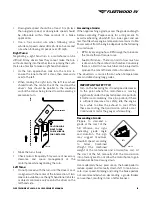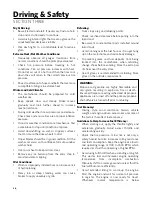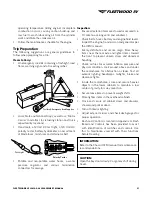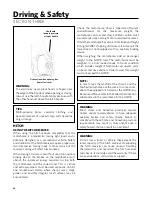
20
Driving & Safety
SECTION THREE
Night Driving:
• Be well rested and alert . If necessary, find a safe to
stop and rest until ready to continue .
• Avoid using interior lights that create a glare on the
windshield and decrease visibility .
• Dim dash lights to a comfortable level to reduce
glare .
Extreme Heat/Hot Weather Conditions:
• Frequently observe all gauges . Variations from
normal conditions should be promptly evaluated .
• Check tire pressure before traveling in hot
conditions . Tire air pressure increases with heat .
Do not let air out of a hot tire . When the tires cool
down they will return to the correct/previous tire
pressure .
• Pay extra attention to hoses and belts that are more
susceptible to fatigue in extreme heat .
Winter and Cold Climate:
• The motorhome should be prepared for cold
weather use .
• Keep speeds slow and steady . Make moves
gradually and look further ahead to increase
reaction distance .
• During cold weather tire air pressure can decrease .
Check tires and ensure tires are at proper inflation
pressure .
• If road or weather conditions are treacherous, find
a safe place to stop until conditions improve .
• Avoid downshifting on wet or slippery surfaces
that can cause the drive wheels to skid .
• Wiper blades should be in good condition . Fill the
washer reservoir with antifreeze formula window
washer fluid .
• Use mirror heat to keep mirrors clear .
• Remove any ice build-up from the entry step to
avoid accidental slipping .
Wet Conditions:
• Worn or improperly inflated tires can increase risk
of hydroplaning .
• Heavy rain or deep standing water can cause
brakes to apply unevenly or grab .
Refueling:
• Truck stops are good refueling points .
• Check overhead clearance before pulling into the
fuel island .
• Be aware of concrete/steel posts installed around
fuel islands .
• Avoid running over the fuel hose as it can get hung
up on the motorhome and cause body damage .
• To prevent grease and fuel deposits from being
tracked into the motorhome when refueling,
change shoes before entering . Store the extra pair
of shoes near the entry door .
• Use of gloves is recommended for refueling . Store
gloves in the outside compartment .
Fuel Economy:
• Driving style, wind resistance, terrain, vehicle
weight, and engine-driven accessories are some of
the factors that affect fuel economy .
Guidelines to Help Increase Fuel Efficiency:
• When starting out, apply the throttle lightly and
accelerate gradually . Avoid excess throttle and
accelerating quickly .
• Check the tire pressure . A low tire is not only a
safety hazard but also increases rolling resistance
and fuel consumption . Keep the engine at a low to
mid operating range of 1100 to 1500 RPM, which
requires less fuel than operating at higher RPM .
• Avoid using full throttle when ascending a long hill .
This wastes fuel and increases engine operating
temperature from incomplete combustion .
Manually shift to a lower gear and use less throttle .
Fuel will burn more efficiently .
• Avoid extended idling to warm-up the engine .
Start the engine and wait for normal oil pressure
to register . The engine is now ready for travel .
Whenever coolant temperature is below
WARNING:
Propane and gasoline are highly flammable and
can ignite, resulting in explosion, fire or death .
Ensure all flames are extinguished and all propane
appliances are turned off and the primary propane
shut-off valve is turned off prior to refueling .
Содержание Class A Gas 2020
Страница 173: ...FLEETWOOD RV CLASS A GAS 2020 OWNER S MANUAL 171...
Страница 174: ...172 Notes...
















































